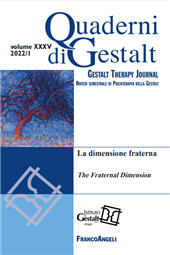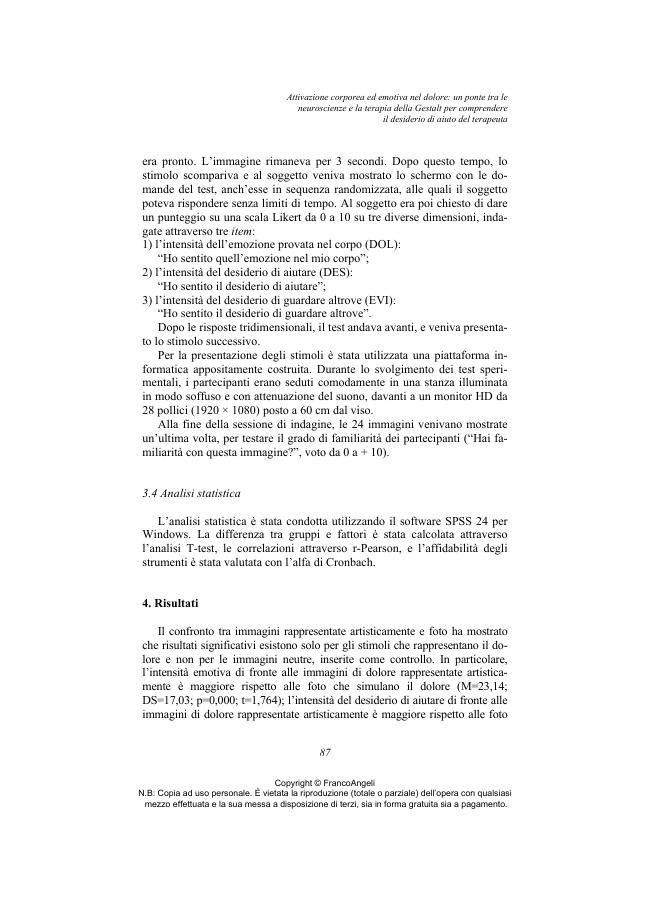Attivazione corporea ed emotiva nel dolore : un ponte tra le neuroscienze e la terapia della Gestalt per comprendere il desiderio di aiuto del terapeuta
P. 81-93
L'attivazione corporea ed emotiva di fronte al dolore è stata collegata al desiderio di aiutare l'altro. Basandosi su precedenti ricerche di neuroestetica, e sul concetto di Conoscenza Relazionale Estetica nel quadro della terapia della Gestalt, la ricerca ha indagato le reazioni di 29 individui di fronte a immagini di dolore e sentimenti neutri, in rappresentazioni artistiche e in foto di attori. Gli individui sono stati testati con SCL-90-R, MAIA e IRI. I risultati confermano l'ipotesi che il desiderio di aiutare è connesso con l'attivazione corporea-emozionale, con la capacità di sentire il proprio corpo e tuttavia tenere l'emozione dell'altro. L'attivazione corporeo-emotiva è stata mostrata solo nella rappresentazione artistica del dolore. Una possibile spiegazione è che il "movimento" che attiva una persona di fronte al dolore è meglio espresso nelle immagini artistiche. [Testo dell'editore]
Bodily and emotional activation in front of pain have been connected with the wish to help the other. Building on previous research of neuro-aesthetics, and on the concept of Aesthetic Relational Knowledge inside the frame of Gestalt therapy, this research investigated on 29 individuals reactions to of images of pain and neutral feelings in artistic representations and in photos of actors. The individuals were tested with SCL-90-R, MAIA and IRI. The results confirm the hypothesis that the wish to help relates to bodily-emotional activation, with the capacity to feel one's own body and yet hold the emotion of the other. Bodily-emotional activation was only shown in artistic representation of pain. A possible explanation is that the "movement" that activates a person in front of the pain is better expressed in artistic images. At the same time, the wish to help relates to the capacity to decentralize from oneself and focus on the other. Lack of empathy is not connected with avoidance to help the other.
Lack of empathy and wish to avoid helping has shown to relate to a feeling of anxiety and mistrust in coping, rather than with lack of empathy. Looking at Gestalt epistemology - based on phenomenology, aesthetics and the experiential field (Perls et al., 1951; Spagnuolo Lobb, 2019), we can conclude that this investigation has confirmed the hypothesis that the desire to help the other is connected with an embodied dimension that expresses the ability to activate oneself, to feel one's own body and to allow oneself to be crossed by the emotion of the other, containing it, as underlined by the concept of empathy in "Aesthetic Relational Knowledge" (Spagnuolo Lobb, 2018). When empathy, understood here as feeling the other's pain (emotional-body activation), is felt most strongly in the body and there is an ability to decentralize from concern for oneself, then the person experiences a tension toward the other, manifesting a desire for help. [Publisher's text]
-
Artículos del mismo número (disponibles individualmente)
-
Información
Código DOI: 10.3280/GEST2022-001006
ISSN: 2035-6994
KEYWORDS
- neuroestetica, terapia della Gestalt, campo fenomenologico, Conoscenza Relazionale Estetica, risonanza intenzionale
- Neuro-Aesthetics, Gestalt Therapy, Phenomenological Field, Aesthetic Relational Knowledge, Intentional Resonance



